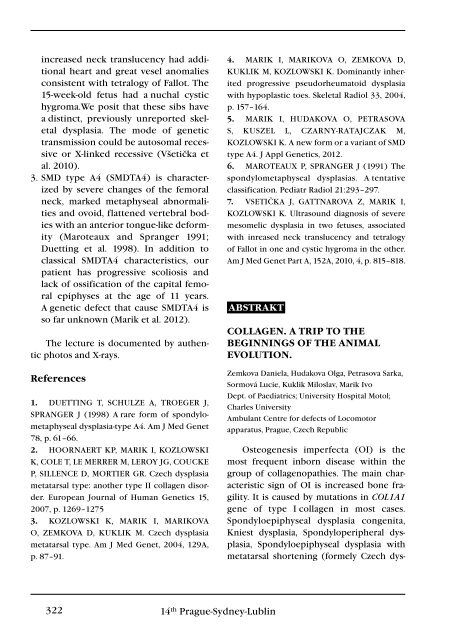3+4+Supplementum/2012 - Společnost pro pojivové tkáně
3+4+Supplementum/2012 - Společnost pro pojivové tkáně
3+4+Supplementum/2012 - Společnost pro pojivové tkáně
- TAGS
- www.pojivo.cz
Create successful ePaper yourself
Turn your PDF publications into a flip-book with our unique Google optimized e-Paper software.
increased neck translucency had additional<br />
heart and great vesel anomalies<br />
consistent with tetralogy of Fallot. The<br />
15-week-old fetus had a nuchal cystic<br />
hygroma.We posit that these sibs have<br />
a distinct, previously unreported skeletal<br />
dysplasia. The mode of genetic<br />
transmission could be autosomal recessive<br />
or X-linked recessive (Všetička et<br />
al. 2010).<br />
3. SMD type A4 (SMDTA4) is characterized<br />
by severe changes of the femoral<br />
neck, marked metaphyseal abnormalities<br />
and ovoid, flattened vertebral bodies<br />
with an anterior tongue-like deformity<br />
(Maroteaux and Spranger 1991;<br />
Duetting et al. 1998). In addition to<br />
classical SMDTA4 characteristics, our<br />
patient has <strong>pro</strong>gressive scoliosis and<br />
lack of ossification of the capital femoral<br />
epiphyses at the age of 11 years.<br />
A genetic defect that cause SMDTA4 is<br />
so far unknown (Marik et al. <strong>2012</strong>).<br />
The lecture is documented by authentic<br />
photos and X-rays.<br />
References<br />
1. DUETTING T, SCHULZE A, TROEGER J,<br />
SPRANGER J (1998) A rare form of spondylometaphyseal<br />
dysplasia-type A4. Am J Med Genet<br />
78, p. 61–66.<br />
2. HOORNAERT KP, MARIK I, KOZLOWSKI<br />
K, COLE T, LE MERRER M, LEROY JG, COUCKE<br />
P, SILLENCE D, MORTIER GR. Czech dysplasia<br />
metatarsal type: another type II collagen disorder.<br />
European Journal of Human Genetics 15,<br />
2007, p. 1269–1275<br />
3. KOZLOWSKI K, MARIK I, MARIKOVA<br />
O, ZEMKOVA D, KUKLIK M. Czech dysplasia<br />
metatarsal type. Am J Med Genet, 2004, 129A,<br />
p. 87–91.<br />
322 14 th Prague-Sydney-Lublin<br />
4. MARIK I, MARIKOVA O, ZEMKOVA D,<br />
KUKLIK M, KOZLOWSKI K. Dominantly inherited<br />
<strong>pro</strong>gressive pseudorheumatoid dysplasia<br />
with hypoplastic toes. Skeletal Radiol 33, 2004,<br />
p. 157–164.<br />
5. MARIK I, HUDAKOVA O, PETRASOVA<br />
S, KUSZEL L, CZARNY-RATAJCZAK M,<br />
KOZLOWSKI K. A new form or a variant of SMD<br />
type A4. J Appl Genetics, <strong>2012</strong>.<br />
6. MAROTEAUX P, SPRANGER J (1991) The<br />
spondylometaphyseal dysplasias. A tentative<br />
classification. Pediatr Radiol 21:293–297.<br />
7. VSETIČKA J, GATTNAROVA Z, MARIK I,<br />
KOZLOWSKI K. Ultrasound diagnosis of severe<br />
mesomelic dysplasia in two fetuses, associated<br />
with inreased neck translucency and tetralogy<br />
of Fallot in one and cystic hygroma in the other.<br />
Am J Med Genet Part A, 152A, 2010, 4, p. 815–818.<br />
aBSTRakT<br />
COllaGen. a TRiP TO THe<br />
BeGinninGS Of THe aniMal<br />
eVOluTiOn.<br />
Zemkova Daniela, Hudakova Olga, Petrasova Sarka,<br />
Sormová Lucie, Kuklik Miloslav, Marik Ivo<br />
Dept. of Paediatrics; University Hospital Motol;<br />
Charles University<br />
Ambulant Centre for defects of Locomotor<br />
apparatus, Prague, Czech Republic<br />
Osteogenesis imperfecta (OI) is the<br />
most frequent inborn disease within the<br />
group of collagenopathies. The main characteristic<br />
sign of OI is increased bone fragility.<br />
It is caused by mutations in COL1A1<br />
gene of type I collagen in most cases.<br />
Spondyloepiphyseal dysplasia congenita,<br />
Kniest dysplasia, Spondyloperipheral dysplasia,<br />
Spondyloepiphyseal dysplasia with<br />
metatarsal shortening (formely Czech dys-

















